Just Transition Commission: background report
Background information report on the Scottish economy to help inform the early deliberations of the Just Transition Commission.
4. Business and Industry Landscape
Summary of Evidence: Business & Industry
Scotland's onshore economy has grown at a slower rate than the UK average over the past 20 years and continues to feel the effects of the economic downturn.
Scottish productivity growth has slowed but has exceeded UK growth over the past decade: between 2007 and 2017 productivity in Scotland grew at an average annual rate of 0.7 per cent per year, which is higher than the UK average of 0.2 per cent over that period.
Private sector business services (Professional, Scientific & Technical Activities, Information & Communication, Administration & Support Services, and Real Estate Activities) have been Scotland's fastest growing sectors. However, many sectors have experienced a slowdown in economic growth since the recession, contributing to Scotland's weaker overall economic performance.
Scotland's business population is expanding but the rate of churn has increased among the business population, with an increase in the rates of both new businesses start-ups and business closures over the past five years.
Economic Outlook
Reflecting current uncertainty, there are large variations in current forecasts for Scotland. Scottish Fiscal Commission's (SFC) December 2018 forecast is the most pessimistic, projecting subdued economic growth, averaging at just over 1 per cent pa over the next five years.
Other forecasts are more optimistic: SDS 'Jobs and Skills in Scotland' November 2017 report indicate that growth will accelerate and peak at 2.1 per cent in 2021 and then fall year-on-year to 1.5 per cent per annum by 2026. ITEM's December 2018 forecast predicts a dip in growth in 2019 followed by an average of 1.5 per cent per annum growth to 2023.
Productivity growth forecasts are more consistent and broadly flat: the SFC expects GDP per hour to gradually increase over the next five years but remain lower than historic rates. SDS expects little improvement in productivity growth, with growth in GVA per worker increasing to 1.5 per cent in 2019, and then fluctuating between 1.3 per cent and 1.4 per cent up to 2027. This pattern is also Fraser of Allander Institute forecasts for sectors in the Scottish economy.
There are no published forecasts for the Scottish economy beyond 2027.
Policy Context
4.1. Scotland's economic strategy[26] is based on two key pillars:
- Increasing competitiveness, to boost long-term economic growth by supporting Scottish businesses to develop by supporting entrepreneurialism and access to finance, encouraging innovation and help businesses grow domestically and overseas.
- Reducing inequality is not just a social objective but is interdependent with increasing sustainable economic growth over the long term by increasing the number of people who can contribute towards economic prosperity.
4.2. Scotland has the ambition to rank among the top quartile of OECD countries for productivity, equality and sustainability by creating a productive, inclusive and globally competitive economy with a high performing labour market.
4.3. The Council of Economic Advisers[27] highlighted the importance of improving access to patient capital[28] for Scotland's businesses to securing future growth. The Committee pointed to how a lack of access to patient capital impinges on a number of areas fundamental to long-term growth in Scotland:
- Upgrading infrastructure: infrastructure quality underpins long-term growth and has been widely recognised including the Green Paper as a significant impediment to growth in the UK. Investment in infrastructure in the UK is skewed towards and the south-east. For instance, expenditure on transport infrastructure in London is over five times greater per head of population than in Scotland.
- Investing in science, research and innovation: while Scotland's higher education expenditure on research and development (R&D) as a proportion of GDP is amongst the highest in the Organisation for Economic Co-operation and Development (OECD), business expenditure on R&D (BERD) is amongst the lowest, and significantly below the UK rate (with the UK itself having a relatively low rate of BERD as a share of GDP internationally).
- Supporting businesses to start and grow: Scotland's business birthrate is significantly below that for the UK. Scotland also consistently lags behind UK overall in terms of high-growth enterprises as a share of the business base - in 2014, 7.2% of the UK business base was high growth firms, compared against 6.7% for Scotland.
4.4. Business investment as a percentage of GDP has fallen over time for Scotland and has been between 7 and 8% of GDP, a consistently lower level than that for the UK, whose rate of business investment is itself low by international standards.
The Evidence Base: Economic Growth and Productivity
Economic growth in Scotland has lagged behind the UK average over the past 20 years and has struggled to recover to long-term rates since the recession
4.5. Scotland's economy has grown at a slower rate than the UK average over the past 20 years[29] and continues to feel the effects of the economic downturn.
4.6. Prior to the financial crisis, the Scottish economy grew by 2.0 per cent per annum in real terms (1997-2008), which was slower than UK average growth (2.6 per cent pa).
4.7. Scotland's economy was subsequently hit by recession, but less severely than the UK. In 2009, Scottish GDP fell by 2.4 per cent – which was much less steep than the UK-wide fall of 4.2 per cent – and took until 2013 to return to pre-recession levels.
4.8. Since entering the recovery period, economic growth across Scotland has lagged historical rates and has remained much weaker than across the UK. Between 2009 and 2013, GDP grew by 1.0 per cent per annum – below the UK average rate of 1.7 per cent. The Scottish economy has since struggled to strengthen with growth of 1.1 per cent per annum between 2013 and 2017 – half the rate of the UK-wide economy (2.2 per cent pa).
Fig 4.1: Real GVA Growth
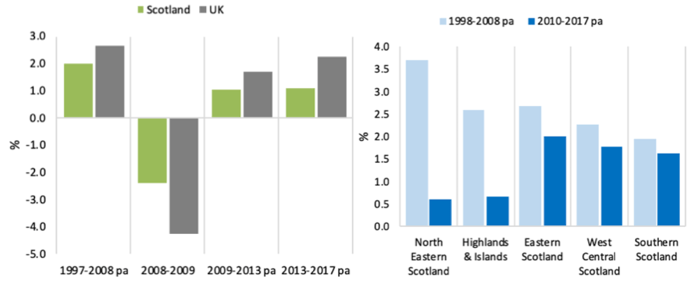
Source: Regional GVA (Balanced), ONS
All regions have experienced a dip in growth compared to their historic rates, particularly North Eastern Scotland and Highlands and Islands
4.9. Eastern Scotland and West Central Scotland are Scotland's biggest contributors to economic output, together accounting for two thirds of all Gross Value Added (GVA) in 2017.
4.10. Eastern Scotland has been Scotland's strongest performing region in recent years, with GVA growing by 2.0 per cent pa in real terms between 2010 and 2017. This was in line with the UK average. All other regions have experienced below-average growth, particularly North Eastern Scotland (0.6 per cent pa) and Highlands and Islands (0.7 per cent pa).
4.11. The economies of all regions have weakened since the 2008/09 financial crisis with recent growth rates lagging their historic rates. This is particularly the case in North Eastern Scotland with growth falling from 3.7 per cent pa during 1998-2008 – the strongest rate of all Scottish regions – to 0.6 per cent pa during 2010-2017. This is likely to be linked to the downturn in the oil and gas sector. Highlands and Islands has also experienced a steep drop in growth, from 2.6 per cent pa to 0.7 per cent pa over the same periods.
Productivity growth has slowed but has exceeded UK rates over the past decade
4.12. In line with the slowdown in economic growth since the recession, productivity growth has also slowed. Between 2013 and 2017, GVA per hour in Scotland grew by an average of just 0.1 per cent pa in real terms, down from the pre-recession rate of 1.4 per cent pa (1998-2008).
4.13. However, Scottish productivity growth has exceeded UK-wide growth over the past decade. Between 2007 and 2017, productivity in Scotland grew at an average annual rate of 0.7 per cent per year, which was close to the EU and OECD averages of 0.8 per cent, and higher than the UK average of 0.2 per cent over that period.
4.14. Subregional productivity statistics show that there is wide variation in productivity rates between Scottish regions. In 2016, people working in Scotland produced an average of £32.38 of GVA per hour. This was slightly lower than the UK average productivity rate (£32.58 per hour), although some Scottish regions exhibited high productivity (North Eastern Scotland £36.3 per hour and Eastern Scotland £33.3 per hour).
Fig 4.2: GVA per hour, 2004-16
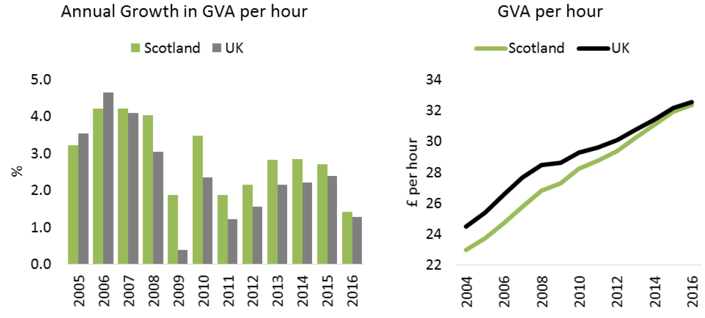
Source: Subregional Productivity, ONS
Real Estate, Renting & Business Activities is Scotland's biggest contributor to economic output
4.15. The Real Estate Activities sector is Scotland's biggest contributor to economic output. Producing £16.5 billion of GVA in 2017[30] (in 2016 prices), it represented 12.1 per cent of all economic output. This was followed by Manufacturing (10.4 per cent), Health (9.7 per cent) and Wholesale & Retail (9.5 per cent). Compared to the UK picture, public sector services and the primary and production industries were more heavily represented in Scotland, while most private sector services accounted for smaller shares of output.
Fig 4.3: Share of GVA by sector, 2017
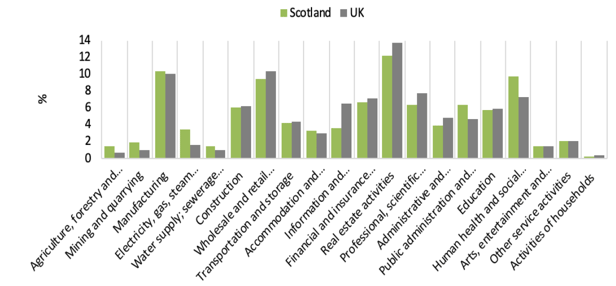
Source: Regional GVA (Balanced), ONS
Utilities, Accommodation & Food Services and Real Estate, Renting & Business Activities have been Scotland's fastest growing sectors since the economic downturn
4.16. Since the economic downturn, the fastest growing sectors across Scotland have been private sector business services: Professional, Scientific & Technical Activities (a 32.2 per cent increased in GVA in real terms between 2010 and 2017), Information & Communication (27.8 per cent), Administration & Support Services (24.9 per cent) and Real Estate Activities (21.1 per cent). This is similar to the UK-wide picture.
4.17. Four sectors have experienced a decline in output since 2010: Arts, Entertainment & Recreation (-18.6 per cent), Activities of Households (-14.9 per cent), Public Administration & Defence (-2.0 per cent), and Financial & Insurance Activities (-1.2 per cent). These sectors also experienced a UK-wide decline, except Arts, Entertainment & Recreation.
4.18. Three sectors are notable in that their performance has been much stronger – or less weak – than across the UK since 2010: Mining & Quarrying (Scotland 4.3 per cent; UK -19.1 per cent), Electricity, Gas, Steam & Air Conditioning Supply (Scotland 6.7 per cent; UK -11.4 per cent) and Public Administration (Scotland -2.0 per cent; UK -12.9 per cent).
4.19. However, many sectors have experienced below-average growth, contributing to Scotland's weaker overall economic performance. Sectors experiencing growth well below the UK average have been Arts, Entertainment & Recreation (Scotland -18.6 per cent; UK 7.5 per cent), Administrative & Support Services (Scotland 24.9 per cent; UK 48.0 per cent), Water Supply, Sewerage & Waste Management (Scotland 8.0 per cent; UK 24.0 per cent), and Construction (Scotland 10.7 per cent; UK 21.9 per cent).
Fig 4.4: GVA Growth by Sector, 2010-17
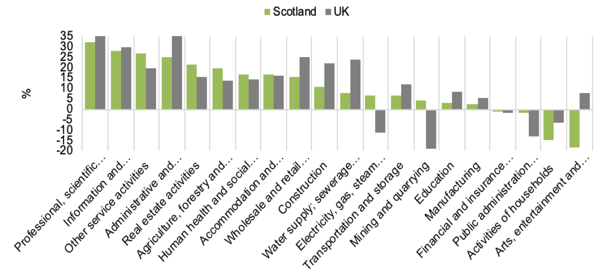
Source: Regional GVA (Balanced), ONS
All but four sectors have experienced a slowdown in economic growth since the recession, particularly Financial & Insurance
4.20. While some sectors have experienced slightly stronger growth since 2010 compared to historical rates – particularly Other Service Activities (3.4 per cent per annum 2010-2017, compared to 0.1 per cent pa 1998-2008) and Agriculture, Forestry & Fishing (2.6 per cent pa 2010-2017, compared to 0.5 per cent pa 1998-2008) – many have experienced weaker growth. Arts, Entertainment & Recreation and Financial & Insurance have experienced the biggest deterioration, followed by Administrative & Support Services, Professional, Scientific & Technical Activities, Information & Communication, and Health & Social Work.
Fig 4.5: GVA growth per annum by sector, 1997-08 and 2010-17
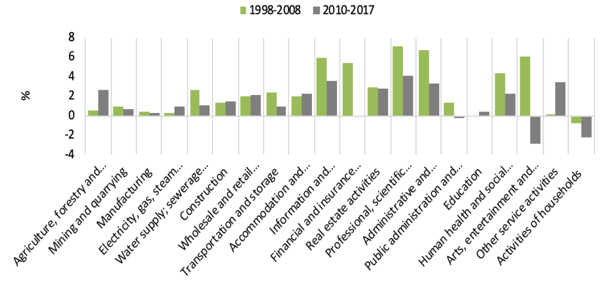
Source: Regional GVA (Balanced), ONS
Scotland's Businesses
Scotland's business population is expanding
4.21. There were 331,365 businesses operating in Scotland in 2018, of which 181,600[31] were VAT and/or PAYE registered. Around one quarter of VAT/PAYE registered businesses were based in the North East (26.1 per cent) and South East (25.1 per cent), around one fifth in the West (20.5 per cent) and South West (18.0 per cent), and one-tenth in the North (10.3 per cent).
4.22. Since 2012, the number of VAT/PAYE registered businesses have increased by 23,300, or 14.7 per cent. At regional level, growth ranged from 14-18 per cent in all regions apart from the North, which experienced growth of just 6.3 per cent. The business population across Scotland – and all regions – has increased faster than the resident population, with 335 businesses per 10,000 people in 2017, up from 298 in 2012.
4.23. Growth in the business population has been driven by an increase in the number of Business Administration & Support Services, Mining, Quarrying & Utilities, and Information & Communication businesses, and an increase in the number of micro businesses.
4.24. The largest sector (in terms of the business base) within Scotland is Professional, Scientific & Technical, accounting for 18.0 per cent of all VAT/PAYE registered businesses, followed by Construction (11.6 per cent) and Agriculture, Forestry & Fishing (9.9 per cent). At regional level, Professional, Scientific & Technical is the largest sector in North East (23.4 per cent), South East (19.2 per cent) and West (18.5 per cent) while Agriculture, Forestry & Fishing is the largest sector in the North (24.1 per cent) and Construction in the West (13.7 per cent).
Fig 4.6: Number of businesses by industry, 2018
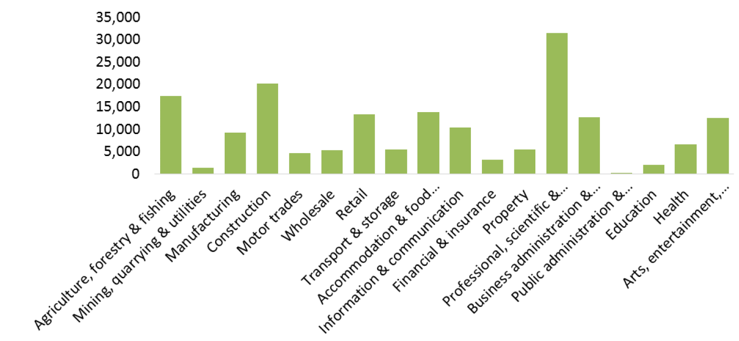
Source: UK Business Counts, ONS
4.25. Over the past five years, five sectors have seen their business base increase by more than 25 per cent. These include: Business Administration & Support Services (48.9 per cent), Mining, Quarrying & Utilities (35.8 per cent), Information & Communication (30.3 per cent), Financial & Insurance (28.3 per cent), and Transport & Storage (25.5 per cent) – although in absolute numbers, the biggest increase has been in the Professional, Scientific & Technical sector (+4,800). During this time, three sectors have seen their business base shrink: Public Administration & Defence (-16.7 per cent), Retail (-2.4 per cent), and Wholesale (-1.1 per cent).
Fig 4.7: Total and percentage change in the number of businesses, 2013-2018
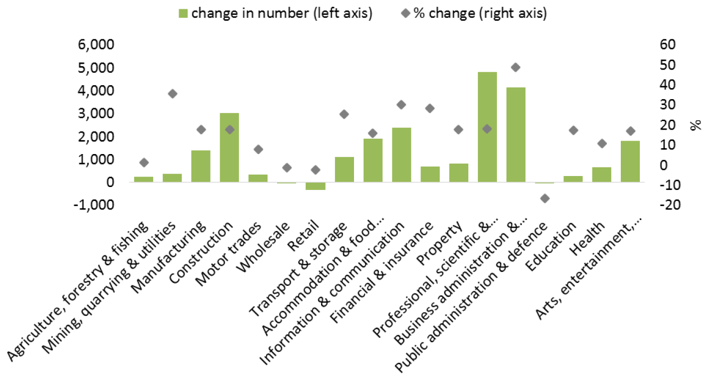
Source: UK Business Counts, ONS
4.26. The majority of businesses in Scotland are micro businesses, comprising 87.9 per cent of the business population in 2018. It is micro businesses that have accounted for the majority of growth in Scotland's business base over the past five years (93.1 per cent of all growth during 2013-18). This has been the case in all regions, particularly the North East (97.3 per cent of all growth).
The rate of churn has increased among the business population
4.27. The rate of churn has increased among the business population, with an increase in the rates of both new businesses start-ups and business closures over the past five years – nationwide and in all regions. In 2017, 21,600 new businesses started in Scotland, equivalent to 39.8 per 10,000 population – up from 32.7 in 2012. At the same time, there were 20,240 business deaths, equivalent to 37.5 per 10,000 population – up from 31.1 in 2012.
Fig 4.8: Rate of business births and deaths per 10,000 population, 2012 and 2017
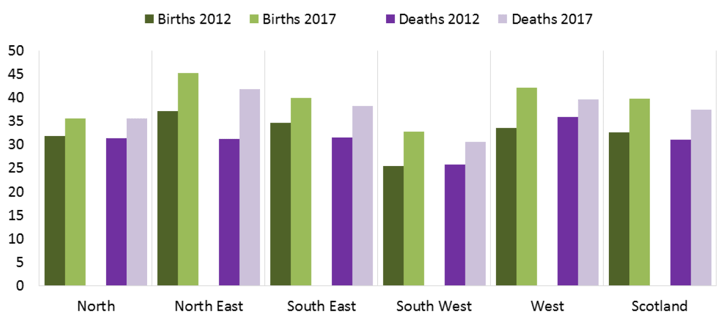
Source: Business Demography, ONS
The environment for new businesses has become more challenging
4.28. An increase in the business death rate highlights a more challenging environment for new businesses – with the rate of survival of new businesses falling over the past few years. Between 2013 and 2016, the percentage of businesses surviving their first year fell from 94.0 per cent to 91.7 per cent. And, looking at longer-term survival rates, businesses created in 2012 were less likely to survive for five years (43.7 per cent survival rate) than those born in 2007 (47.4 per cent).
Fig 4.9: Survival rates of new businesses
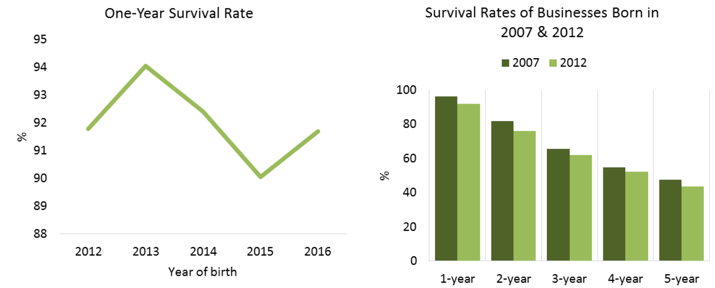
Source: Business Demography, ONS
Knowledge and Innovation
The number of knowledge economy jobs has increased
4.29. Knowledge-intensive activities have increasingly been recognised as important to supporting sustainable economic growth. Creating a greater reliance on intellectual capital rather than physical inputs provides access to long-term stable growth.
4.30. In 2017, there were 437,300 jobs in Knowledge Economy (KE) industries[32], equivalent to 16.9 per cent of all jobs (lower than the Great Britain share of 20.1 per cent). There was wide variation in KE employment between regions, with the share of KE jobs ranging from 8.6 per cent in the North to above the Great Britain average in the West (20.3 per cent) and the South East (22.7 per cent).
4.31. Between 2015 and 2017, the number of KE jobs in Scotland increased by 17,400 – which, at 4.1 per cent, was in line with the Great Britain average, (4.2 per cent). The largest increase was in the North (+10.4 per cent) while KE jobs increased by just 0.5 per cent in the North East. Within KE sectors, the biggest increase in jobs was among Business support service activities n.e.c. (+6,000), Activities auxiliary to financial services, except insurance and pension funding (+3,000), Legal activities (+3,000), Activities of head offices (+3,000), Architectural and engineering activities and related technical consultancy (+3,000), and Motion picture, video and television programme activities (+2,000). In contrast, there was a sharp fall in Monetary intermediation jobs (-7,000).
The number of high and medium technology manufacturing jobs has fallen
4.32. In 2017, there were 58,900 high and medium technology manufacturing (HMTM)[33] jobs in Scotland, equivalent to 2.3 per cent of all jobs (lower than the Great Britain share of 3.0 per cent). At regional level, the share of HMTM jobs ranged from 1.1 per cent in the North to 3.0 per cent in the North East.
4.33. Between 2015 and 2017, the number of HMTM jobs in Scotland fell by 1,500, or 2.5 per cent, against a 3.4 per cent increase across Great Britain. This was driven by a fall in HMTM jobs in the North East (-3,500, or -15.7 per cent) and by a fall in jobs in the Manufacture of electronic components and boards (-1,000), Manufacture of general purpose machinery (-1,000), and Installation of industrial machinery and equipment (-1,000).
Fig 4.10: Share of all jobs in KE and HMTM sectors, 2017
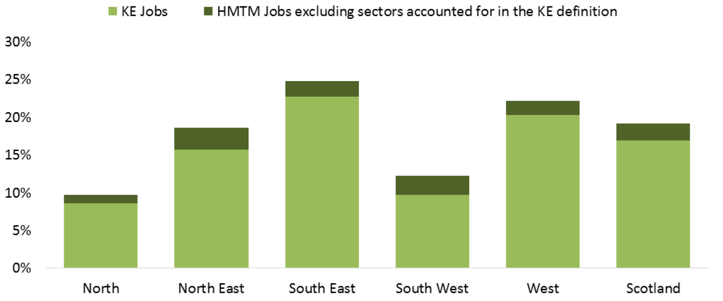
Source: Business Register and Employment Survey, ONS
Business expenditure on research and development and R&D employment have increased rapidly
4.34. Businesses in Scotland spent £1.2bn on R&D in 2017. Two-thirds of this expenditure was concentrated among four sectors: Miscellaneous Business Activities; Technical Testing & Analysis (£309m), Electrical Machinery (£215m), Chemicals (£179m), and Other Manufacturing (£122m).
4.35. Over the past five years, the value of business expenditure on research and development (BERD) in Scotland has increased by more than any other UK nation and region except London. Between 2012 and 2017, BERD increased by 76.0 per cent – well above the UK average increase (56.4 per cent) and just below London (78.0 per cent). As a result, BERD as a share of GDP increased to 0.80 per cent from 0.54 per cent (although this remained below the UK average of 1.15 per cent). Employment on R&D performed within businesses in Scotland has also increased by 58.0 per cent over the past five years, from 8,300 in 2012 to 13,200 in 2017.
Fig 4.11: BERD, 2012-17
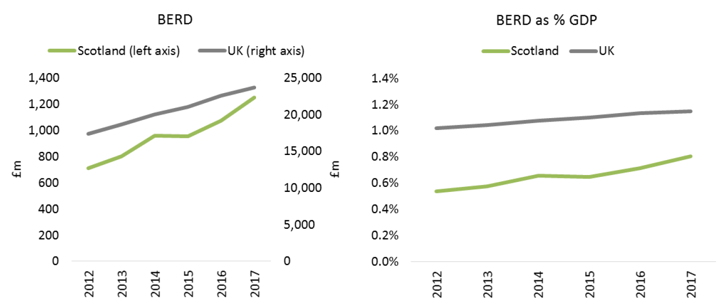
Source: Business Enterprise Research and Development Scotland 2017
Economic Outlook
There are large variations in recent economic growth forecasts published for Scotland, reflecting uncertainty about the economic outlook.
4.36. The Scottish Fiscal Commission's (SFC) December 2018 forecast is the most pessimistic, projecting subdued economic growth, averaging at just over 1 per cent pa over the next five years. This is primarily due to projected slow productivity growth as well as slow population growth, weak demand from the oil and gas industry due to volatile oil prices, the effect of Brexit on the economy, and weak growth in household incomes.
4.37. The EY Scottish ITEM Club and Skills Development Scotland (SDS) are the most optimistic. The forecasts contained within the SDS 'Jobs and Skills in Scotland' November 2017 report indicate that growth will accelerate and peak at 2.1 per cent in 2021 and then fall year-on-year to 1.5 per cent per annum by 2026. ITEM's December 2018 forecast predicts a dip in growth in 2019 followed by an average of 1.5 per cent per annum growth to 2023.
Fig 4.12: Output growth forecasts, constant prices, 2018-2027
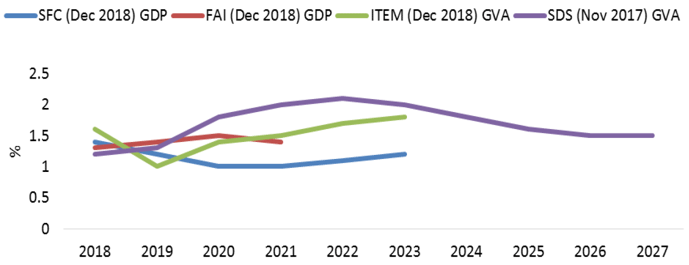
Source: Scotland's Economic and Fiscal Forecasts – December 2018, Scottish Fiscal Commission; Fraser of Allander Institute Economic Commentary – December 2018; EY Scottish ITEM Club 2019 Forecast – December 2018; Jobs and Skills in Scotland – November 2017, Skills Development Scotland
4.38. With regards to productivity, the SFC expects GDP per hour growth to gradually increase over the next five years but remain lower than historic rates. SDS expects little improvement in productivity growth, with growth in GVA per worker increasing to 1.5 per cent in 2019, and then fluctuating between 1.3 per cent and 1.4 per cent up to 2027.
Fig 4.13: Productivity growth forecasts, 2018-2027
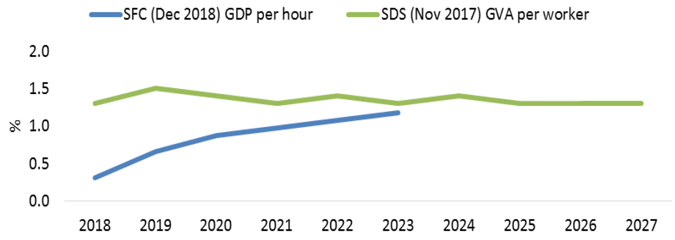
Source: Scottish Fiscal Commission (Dec 2018) and Skills Development Scotland (Nov 2017)
4.39. At sector level, the Fraser of Allander Institute (FAI) expects little change in growth rates across the three broad sectors up to 2021, with Production experiencing the strongest growth of 1.6-1.7 per cent per annum.
Fig 4.14: Forecast GDP growth by sector, 2018-21
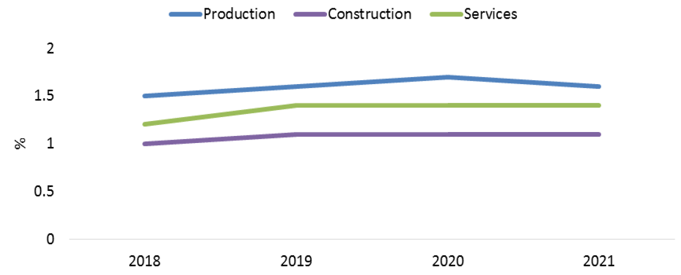
Source: Fraser of Allander Institute (Dec 2018)
4.40. ITEM expects private sector services to continue to drive the Scottish economy up to 2022, with strong growth among Professional, Scientific & Technical Activities, Information & Communication, Administrative & Support Services, and Real Estate, Renting & Business Activities. In contrast, ITEM projects a sharp slowdown in Manufacturing growth between 2019 and 2022, following strong growth in 2018.
4.41. Three sectors are expected to contract over the forecast period, particularly Public Administration & Defence, with year-on-year falls of between -0.6 and -1.0 per cent. Agriculture is also expected to contract between 2019 and 2021, while Mining & Quarrying is expected to shrink between 2020 and 2022.
Fig 4.15: Forecast GDP growth by sector, 2018-22
| 2018 | 2019 | 2020 | 2021 | 2022 | |
|---|---|---|---|---|---|
| Agriculture, forestry & fishing | -1.7 | -0.6 | -0.3 | -0.1 | 0.3 |
| Mining & quarrying | 0.6 | 1.1 | -0.9 | -1.0 | -0.8 |
| Manufacturing | 4.0 | 0.3 | 0.6 | 0.8 | 1.0 |
| Electricity & gas supply | 2.3 | -0.4 | 1.2 | 1.2 | 1.5 |
| Water supply & waste management | 2.4 | 1.3 | 1.0 | 1.2 | 1.5 |
| Construction | -0.1 | 3.0 | 1.6 | 1.1 | 1.3 |
| Retail & wholesale | 2.3 | 1.6 | 1.1 | 1.0 | 1.3 |
| Transportation & storage | 3.6 | 0.3 | 0.7 | 0.9 | 1.1 |
| Accommodation & food services | 3.9 | 1.4 | 1.4 | 1.6 | 1.6 |
| Information & communication | 2.0 | 2.5 | 2.8 | 3.0 | 2.7 |
| Financial & insurance | 2.0 | 0.6 | 0.5 | 0.8 | 1.8 |
| Real estate, renting & business activities | 0.7 | 1.2 | 1.8 | 1.9 | 2.0 |
| Professional, scientific & technical activities | 0.4 | 2.7 | 2.9 | 2.9 | 2.9 |
| Administrative & support services | 4.0 | 1.6 | 2.6 | 2.4 | 2.7 |
| Public administration & defence | -0.3 | -1.0 | -0.8 | -0.7 | -0.6 |
| Education | -0.2 | 0.3 | 0.7 | 0.6 | 0.6 |
| Human health & social work | 1.0 | 0.7 | 1.1 | 1.4 | 1.6 |
| Other service activities | 1.2 | 0.1 | 0.2 | 0.6 | 0.9 |
| Total GVA | 1.6 | 1.0 | 1.4 | 1.5 | 1.7 |
Source: EY Scottish ITEM Club (Dec 2018)
Impact of Industry 4.0 on employment
4.42. Industrial Digital technologies (IDTs) are already transforming industry. The convergence of relatively cheap computing power, data storage, digital sensors, robotics and artificial intelligence will have profound impacts on business, employment and skills[34]. Whereas previous waves of technological development have tended to automate standard and routine tasks in the workplace, IDTs have the potential to impact on a much wider range of tasks – Artificial Intelligence processes have already been demonstrated to be faster and more accurate in collecting and processing data – accounting procedures, paralegal work, transaction process and some medical diagnoses.
4.43. Forecasting which occupations will be affected and the degree to which employees will be replaced by robots or machines is not straightforward. Estimates vary from 10-60% of jobs being at risk of automation from current and forthcoming technologies[35]. Many studies also suggest that all occupations will need to evolve alongside increasingly capable machines.
4.44. Applying estimates for the UK of the proportion of workers at potential high risk of automation to Scotland's employment structure in 2017 suggested that just under 30% of total employment was vulnerable[36]. These are very broad-brush estimates do not include the additional jobs created to serve the development of Industry 4.0 nor the wider economic benefit from induced growth. Modelling future scenarios for UK employment using an approached developed by Boston Consulting Group produced a number of scenarios where the improvement in sector performance will drive net employment growth. In the base case, a loss of almost 300,000 jobs will be offset by a gain of 100,000 new jobs and 370,000 jobs created through growth[37].
4.45. The speed at which these changes will occur is perhaps more difficult to judge. The adoption of IDTs has already started and is gathering pace but many studies expect full implementation to occur within 15-20 years.
Figure 4.16: Speed of impact of AI by sector
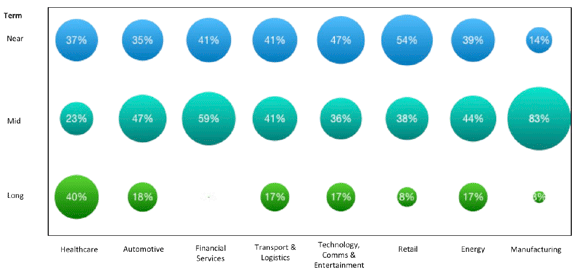
Source: PwC 2017. Near term 0-5 years, Mid 5-10 and Long 10+
4.46. Factors that affect the pace of automation will be:
- Technical feasibility
- Cost of developing and deploying solutions
- Labour market dynamics – skill shortage areas will automate more quickly as the costs of unfilled vacancies affect business performance
- Economic benefits – productivity and quality benefits
- Regulatory and social acceptance will affect pace of adoption[38]
4.47. The research to date has focused more on the employment impacts of Industry 4.0. Business may find distinct advantages especially in those sectors where key skills are in short supply and automation provides a solution to such constraints on production.
Contact
Email: Gregor.Auld@gov.scot
There is a problem
Thanks for your feedback